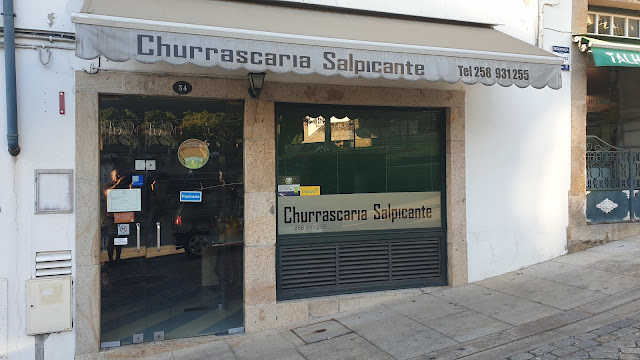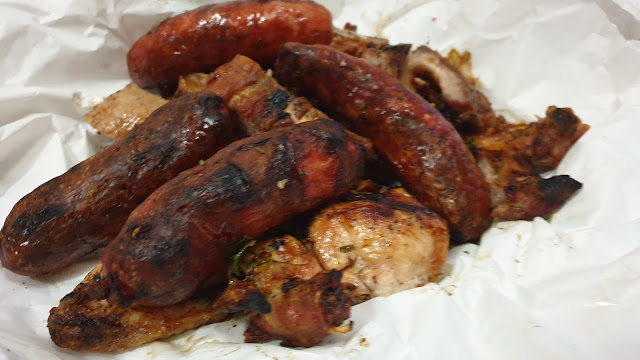1 September 2022
We stayed at Ponte de Lima for three nights. Very pleasent little town and very much on the tourist trail (if the number of cars in the huge free car park was anything to go by).
The town is on the river Lima, hence the name and is historically significant as a it was orginally a Roman settlement on the road from Braga to Santiago de Compostela. When the Romans legionnaires first encountered the river they were so taken with its beauty they believed it to be the river Lethe - Lethe being the river that flows through the underworld and should you drink or bath in it you will lose all memory. Suffice to say they weren't that keen on crossing it and took more than a bit of convincing by their commander one General Decimus Junius Brutus Callaicus.
Whilst there we had two quite memorable evening meals (and one that was a bit meh - quantity over quality). The first was a cheapy as we discovered this place. Basically if was BBQ'd meats freshly cooked over charcoal. Our dinner compromised of four sausages, 1/2 a chook and some very tender pork ribs and chips. Over ordered which was great as we had leftovers for lunch the next day.
The second meal was at a quite up market restaurant the regional speciality is called Arrozz de Sarrabulho with Rojes. Which is basically pork stew (braised pork, two type of black pudding, sausage and of course potatoes) served with rice cooked with shredded pork, spices, red wine and thickened blood and it was delicious. We ate this at a restaurant called Manuel Padeiro which we found was to be v popular with the locals as by 8:30 they were turning away customers. We were sitting outside with 18 other diners of which at least 16 ordered Arrozz de Sarrabulho w Rojes.

One of the main reasons for visiting Ponte de Lima was so that we could do a day trip to about as far north as you can get without hitting Spain to visit a village called Soajo to see some espigueiros - granite granaries built above the ground. Espigueiros means “spikes,” and these granaries are supported on granite slabs from the Peneda mountains. They were built off the ground to protect food crops from rats and other rodents by means of a large disc at the top of the supporting legs of the granary. The walls of each granary have grooved slots (about 5mm wide) carved into them which we assume is to allow for air flow to stop the grain from going moldy.
Built in the 1700s they are still in use today.
After visiting the granaries and having the obligatory mid morning coffee and pastries we saw on a local information board reference to something in the village square called Pelourinho de Soajo so went for a nosey. A bit investigation of revealed that a Pelourinho is a Pillory post - something criminals would be chained to to be pilloried - no idea the significance of the smiley face or the triangular slab at the top.

From there we decided to do a trip out to the coast and have a look a Viana do Castelo (five sided fortress, seaside town and nice old quarter). Had a quick look at the five sided fortress - quick as it was in one of those area that just felt seedy. High above the town is the impressive Santuário de Santa Luzia (accessible by cable car). However after a very stressful 20 or so minutes driving around looking for a car park we flagged Viana do Castelo away and decided to drive down the coast a few ks and locate a seaside town where we could have a picnic of leftover BBQd meats.

The seaside town we chose was Castelo do Neiva and getting to the beach was a tad problematic as google maps decided to take us through the heart of the old part of the village. We got the stage where to go any further we would have had to fold in the wing mirrors and decided to do a backtrack and follow some cars and see where they ended up. 5 minutes later we hit the beach. Below is a screen shot where we decided to stop following google maps!
V pretty but like alot of the atlantic coast a bit wild and windy, but a great place for a picnic (handy seats above the beach).
During our stay in Ponte de Lima there was definitely some sort of celebration going on as masses of cars turned up and the town was surging with people and later that evening, actually it was the early hours of the next morning, at 20 to 1 there was a massive fireworks display.
During the day was a series of races along the river of 5 to 15 year olds on canoes, stand up paddle boards etc. Would love to know who though that paddling a canoe while kneeling on one knee was a good idea - poor kids who were doing this would paddle furiously for about 20m and then, because paddling only one side makes your path curve, lift your kneeling leg and stick it in the water to act as a drag to straighten your course - while balancing on one bent leg in a canoe.
From Ponte de Lima we head south to Aveiro - aka the Venice of Portugal.















Got to love a bit of Roman bridge!
ReplyDelete